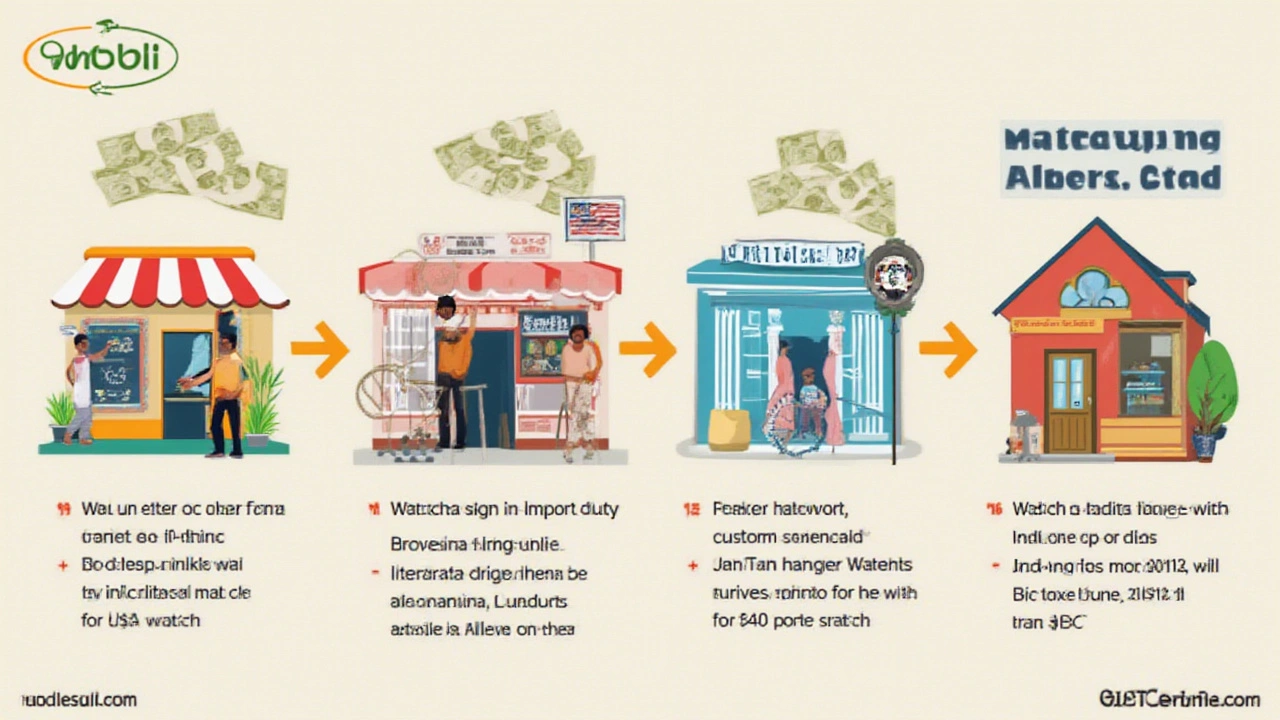Ever wondered if snagging a shiny new watch in the USA will save you a nice chunk of change compared to getting it in India? That question isn’t just on the mind of first-time buyers but also of seasoned collectors who jet-set around the globe. The hype is strong—some say watches are a total steal in the States, while others grumble about hidden costs. So, where are you more likely to find the best deal?
How Watch Prices Stack Up: USA vs. India
First off, it’s not just about the price tag printed on that luxurious Rolex, Omega, or Tissot box. In the USA, watch prices can look pretty attractive, especially when you peek at international brands. For example, a classic Omega Seamaster might retail in the U.S. for $5,000, while the same model could cost upwards of ₹5,25,000 in India. If you do a quick currency conversion (as of July 2025, $1 sits at about ₹83), you’d think the U.S. price comes out lower. On paper, it does—$5,000 is roughly ₹4,15,000. That’s ₹1,10,000 less than the Indian retail price!
But why is there such a gap? Most of it comes down to high import duties and GST (Goods and Services Tax) slapped onto luxury goods shipped to India. The Indian government isn’t shy about taxing foreign watches. As of now, import duty on watches is 20%, with GST at 18%. Watch brands also mark up prices due to distribution costs and after-sales service infrastructure that’s pricier in India than the U.S.
Now, check out this data:
| Brand & Model | USA Price (USD) | India Price (INR) | India Price (USD equivalent) |
|---|---|---|---|
| Rolex Submariner | 9,500 | ₹1,000,000 | 12,048 |
| Omega Seamaster | 5,000 | ₹525,000 | 6,318 |
| Tissot PRX | 375 | ₹42,000 | 506 |
If you’re thinking about snagging a deal in the U.S., keep this in mind: sales tax. In some states (like Oregon or Delaware), there’s zero sales tax. But hop over to California, and you’ll pay 8-10% extra. In India, taxes are already baked into the sticker price—no surprises at checkout. Here’s a tip: if you buy a watch in a U.S. state with no sales tax, you save even more.
Sometimes, sales or festive promotions make watches in local Indian stores more competitive, especially during Diwali sales or during stock clearance periods. But compared to the average American MSRP, watches are almost always pricier in India.
Why Watches Cost More in India: The Real Story
Let’s get honest about why your dream watch costs more once it lands in India. It isn’t the shopkeepers just being greedy. The big factor is Indian import duty on watches, which immediately adds 20% to the base price the moment a watch hits Indian soil. Now add GST—and you’re staring at an 18% hike over the already-taxed sum. Plus, there’s cess for high-value watches that can add another 2-5%. When you stack these, watch prices spiral up quickly.
For luxury brands, distribution models play a role. Brands like Rolex, Omega, and Audemars Piguet only allow authorized dealers to sell their wares, so they maintain a tight grip on pricing. You won’t see wild discounts or gray market deals in official shops. Plus, these brands run exclusive service centers and event experiences in India, which adds to their operating costs, and, you guessed it—cost gets passed on to the buyer.
On top of that, India’s foreign exchange rates are volatile, meaning importers have to hedge against currency risk. If the rupee weakens, tomorrow’s watches cost more to bring in. Some brands prefer to price above the U.S. equivalent to avoid sudden rupee slumps eating into profits.
Let’s not forget about after-sales costs. Offering warranty repairs and spare parts in India is more complex and expensive compared to the USA, where brands have far more logistics muscle. Indian watch buyers get peace of mind, but the service isn’t free—it’s built into the sticker price.
The government has made noise about reducing luxury good duties, but there’s no sign of changes anytime soon. A striking fact from Bloomberg:
"India is among the most expensive markets in the world to buy Swiss luxury goods, due to some of the world’s highest import duties on watches and jewelry."
Now, here’s something most folks miss—parallel imports, or ‘gray market’ watches, do exist in India at lower prices. These watches skip official channels and duties, but they don’t come with brand warranties or support. Saving now could mean pain later if there’s a problem.

Hidden Costs: Buying a Watch Abroad and Bringing It to India
Reverse scenario—what if you buy a watch during your U.S. vacation and carry it home? Many Indian travelers take this route hoping to save serious cash. If you do, make sure you read the fine print. India’s Customs rules let you bring personal items duty-free up to ₹50,000 if you’re coming from the U.S. Go over? That shiny new watch counts against your limit.
Here’s what happens if Customs spots you wearing a $10,000 Rolex and asks for your bill. If it’s above ₹50,000, you’ll be asked to pay duty—28% as of now. That means you could drop another $2,800 at the airport if you’re not careful. Customs officials are pretty smart about high-end luxury items, so gambling on sneaking past isn’t a safe bet.
Warranty is another thing people forget. Watches bought in the USA might not get full service support in India, especially on luxury brands like Rolex. Often, global warranties don’t apply, or you have to send your watch back to the U.S. for repairs, which is time-consuming and not cheap.
One more tip: flight delays, lost bags, and surprise Customs checks can turn your bargain shopping into a stressful experience. Factor in travel costs, U.S. sales tax, and the Customs duty. That ‘10% cheaper’ watch can quickly end up more expensive than if you bought it at home—unless you’re really careful about each detail.
If you have friends or family visiting the U.S., they might offer to bring back a watch for you. But gifting rules are strict. Limits and duties still apply, and watches have to be declared. Don’t risk penalties or confiscation. And remember: the peace of mind you get with a full warranty and support in India may be worth the higher sticker price.
Smart Tips for Buying Watches – Get The Best Deal
If your heart’s set on owning a watch at the best price, a little homework goes a long way. Start by researching prices from authorized dealers in both India and the USA. Check official websites and compare those numbers after converting currencies—don’t forget state sales tax in the U.S. Use reliable currency converters that include transaction charges, since getting cash for your trip or using credit cards always costs a little extra.
Want to buy in the U.S.? Pick states with 0% or low sales tax. Plan for warranty coverage—only buy from official outlets (not third-party gray market dealers) to guarantee support in India if needed. When you’re back home, always keep bills and proof of purchase handy in case Customs asks for paperwork, or you need repairs under warranty. Don’t rely too much on ‘used’ or ‘pre-owned’ sites unless you’re an experienced collector and know how to spot fakes.
- Look out for festive season sales or exclusive events at authorized Indian dealers—sometimes they offer freebies, extended warranties, or rare models you won’t get abroad.
- If you’re in the U.S. for a business trip, consider shopping in New York, Las Vegas, or Miami, where you’ll find flagship boutiques with wider selections.
- Buying from the U.S.? See if the retailer does ‘tax refunds’ for international travelers. Some big stores offer this, though not all watches qualify.
- Always calculate the total cost to land your watch in India—U.S. price + state sales tax + duties (if declarations apply) + shipping or travel costs.
- If the difference is marginal, it might be smarter to buy in India for the warranty and peace of mind alone.
One last heads-up: The Indian watch scene is heating up. Every year, brands launch more limited editions and India-only collections to entice local buyers. Sometimes, rare dials or custom colors are actually easier to get in Mumbai or Delhi than in New York or Los Angeles.
Bottom line—yes, most watches are cheaper in the USA, especially international luxury models. But taxes, import duties, shipping, warranty, and customs rules can make your bargain not so cheap after all. Compare, plan, ask questions, and decide what peace of mind and support are worth to you before you pick your dream watch’s new home. You’d be surprised which side of the globe offers the better deal once you add it all up.

